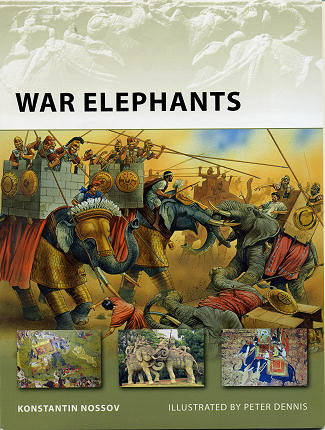 As
most of you know, Osprey provides a number of major topics for their books. One
of my favorites is the New Vanguard series. This series concentrates on the
weapons of war and provides a variety of subjects. Probably
one of the more unusual subjects is this one on war elephants. I have to confess
that it very much surprised me at first, but then I started to think about it
and it made perfect sense that this be in amongst light cruisers, chariots and
UAVs.
As
most of you know, Osprey provides a number of major topics for their books. One
of my favorites is the New Vanguard series. This series concentrates on the
weapons of war and provides a variety of subjects. Probably
one of the more unusual subjects is this one on war elephants. I have to confess
that it very much surprised me at first, but then I started to think about it
and it made perfect sense that this be in amongst light cruisers, chariots and
UAVs.
Unbeknownst to me, the most desirable
elephants to use in this role are what we call the Indian elephant. They are
more aggressive than the somewhat smaller African forest elephant and can be
trained, unlike the much larger African bush elephant. Their training is long
and seems to us to be quite cruel, however, one thing I have learned is that we
should not judge history by modern standards.
The first to use elephants in this manner
were those living in the Indus valley. There were animals aplenty available to
them so it was natural that they'd be utilized. It was in battle with Darius of
Persia that Alexander the Great first ran across them and brought the concept to
the west. They were then used in battle during the reign of Pyrrhus as well as
by the Ptolomys. This lead to their use by others, including the Carthaginians
and even by the Romans.
However, their greatest and longest
lasting utilization was by the peoples of India and Southeast Asia. Here
elephants were a mainstay of armies and used pretty much continuously even into
the 20th century, though the latter usage was more in a utilitarian means to
haul field artillery and supplies.
In his book, author Nossov describes the
background of the subject, their training and equipment as well as how they were
used by various peoples. This is shown by period illustrations and artifacts
left over from those times. It is further enhanced by the artwork of Peter
Dennis, making for a well
rounded publication and a book that I can easily recommend to you for something
interesting and a bit more unusual from the norm.
December 2008
For more on the complete line of Osprey books,
visit www.ospreypublishing.com. In the US, it is
Osprey Direct at 44-02 23rd St, Suite 219, Long Island City, NY 11101., where you can
get a catalogue of available books.
If you would like your product reviewed fairly and quickly, please contact
me or see other details in the Note to
Contributors.
 As
most of you know, Osprey provides a number of major topics for their books. One
of my favorites is the New Vanguard series. This series concentrates on the
weapons of war and provides a variety of subjects. Probably
one of the more unusual subjects is this one on war elephants. I have to confess
that it very much surprised me at first, but then I started to think about it
and it made perfect sense that this be in amongst light cruisers, chariots and
UAVs.
As
most of you know, Osprey provides a number of major topics for their books. One
of my favorites is the New Vanguard series. This series concentrates on the
weapons of war and provides a variety of subjects. Probably
one of the more unusual subjects is this one on war elephants. I have to confess
that it very much surprised me at first, but then I started to think about it
and it made perfect sense that this be in amongst light cruisers, chariots and
UAVs.